Excerpts from Jim Conrad's
Naturalist Newsletter
from the June 14, 2015 Newsletter issued from Río Lagartos, on the Yucatan Peninsula's northern coast (~N21.60°, ~W88.16°), Yucatán state, MÉXICO
ENRIQUEBELTRANIA FLOWERING
Even before last week's first good rain of the rainy season, already many woody species were flowering and/or issuing new leaves. Now that it's rained, so many plants are greening up that it feels like a very hot spring up north. One robustly flowering small tree or shrub caught my attention this week because I'd never seen it before, and its red clusters of small flowers were unusual.
On very thin soil atop limestone, at the edge of the mangroves where during the rainy season sometimes the area must be flooded, its gnarly branches mingled so indiscriminately with those of other usually-spiny woody species that any portrait of the plant would just show a jumble of zigzagging limbs. However, a branch seen against the sky was a pretty thing, shown below:
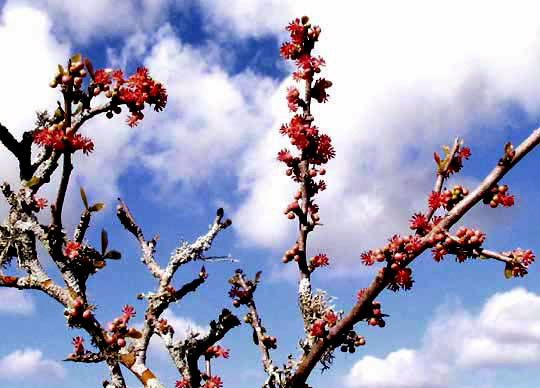
The clusters of red flowers, so eagerly patronized by our aggressive Africanized honeybees that I wouldn't get near some trees, are shown below:
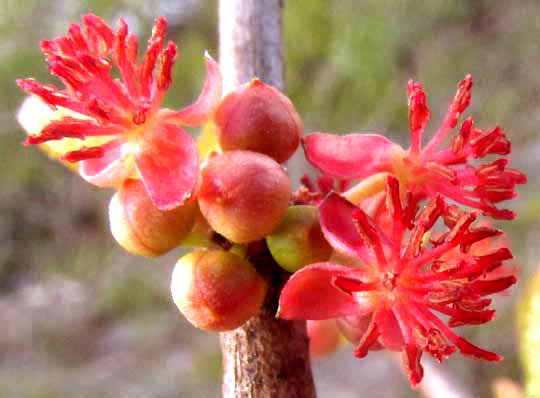
The spherical objects in that picture are unopened flower buds. Each open flower consists of numerous stamens, no corolla, and four calyx lobes, or sepals. No female parts -- no pistil with its stigma, style and ovary -- are visible, so these are unisexual male flowers, and on this and neighboring trees no female flower could be found.
At this point I realized that this might be something special, so I began "doing the botany" more seriously than usual. Here come lots of details, so hold on, or skip to the next entry... :
After searching maybe a dozen trees, finally a female flower was found on a tree with no male flowers. The female flower bore no stamens but rather an asymmetrical ovary with two very long, hairy stigmas atop a very short style, as shown below:
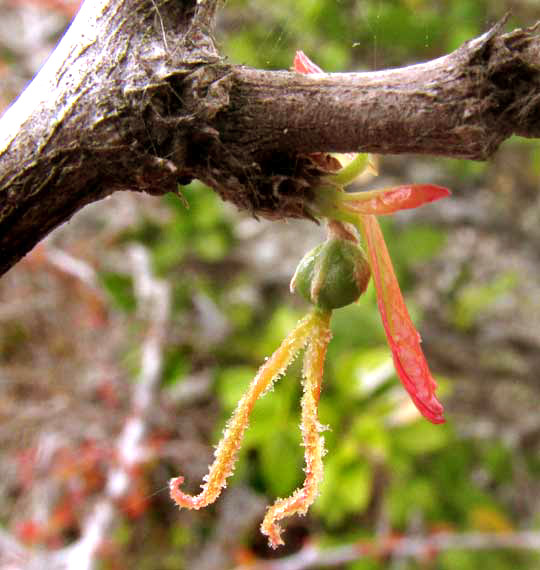
Another plant, hardly knee high, bore a single, more developed but hard to see fruit amidst its gnarly, lichen-covered branches, shown below:
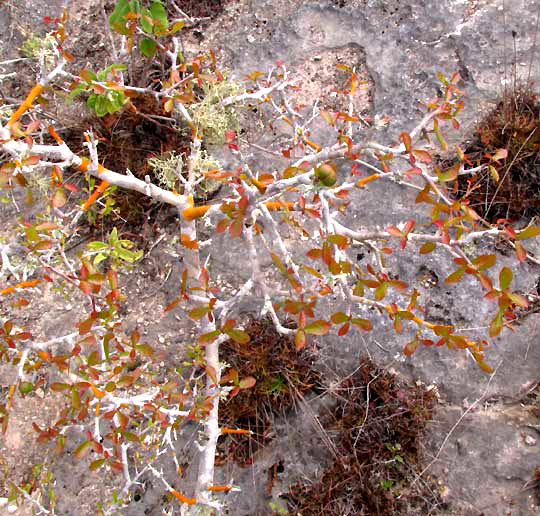
Below, the capsular fruit, which had lost its stigma lobes, is shown closer up:
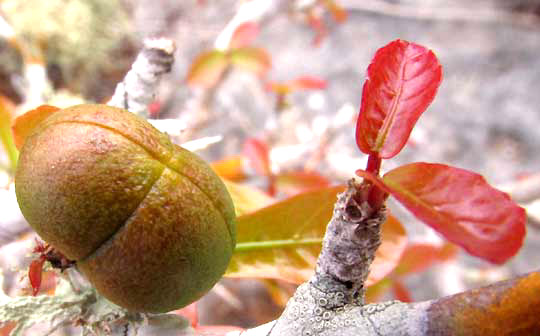
The fruit was atop a short stem, or stipe, as shown below:
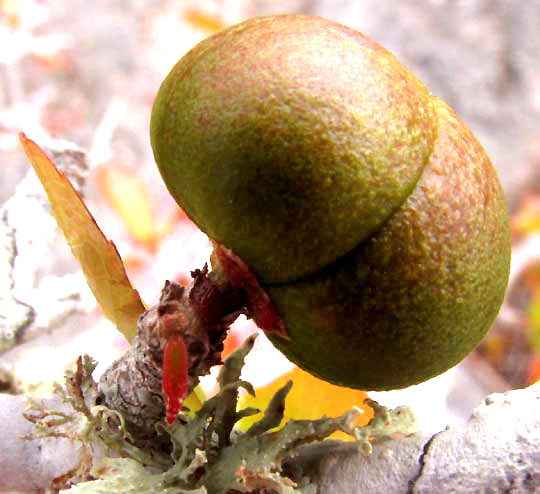
The plant's leaves were immature but a few the size of a fingernail were emerging, and were developed enough to see that when fully formed they'd probably be widest above their middles, bear shallowly eared bases, pinnate venation and shallowly lobed or "crenate" margins, as seen below:
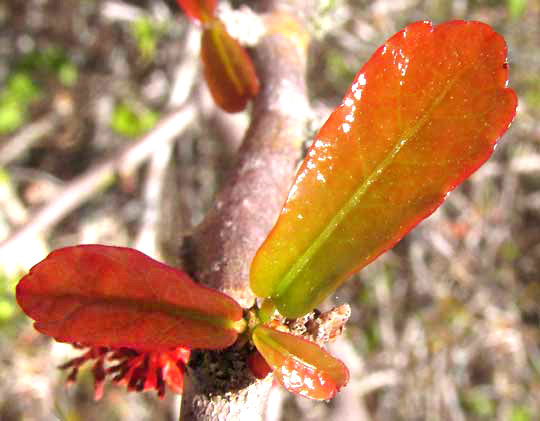
Held against the sky, certain glands and tufts of hairs in the axils between the midrib and veins become visible, as seen below:
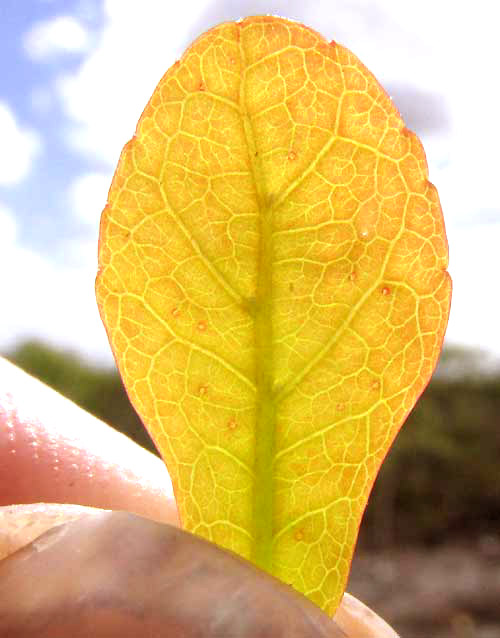
Finally, the tree's pale, splotchy trunk showed that, though it didn't bear regular spines, it produced sharp-pointed, small branches that were "spinescent," as shown below:
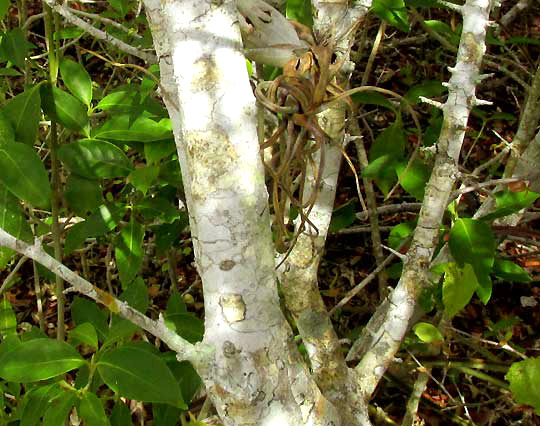
Many hours of looking on the Internet for pictures showing our little tree didn't turn up anything. Because of the unisexual flowers with many stamens and its capsular fruit, I guessed that the plant was a member of the big Euphorbia or Poinsettia Family, the Euphorbiaceae, and so I focused my search on that family. Luckily, a new website providing an interactive key to the world's genera of Euphorbiaceae has just opened up -- one of the best keys like this I've seen -- so I tried it. The key is at http://keys.lucidcentral.org/key-server/player.jsp?keyId=66.
Of the 1078 taxa considered by the key, simply by stating that our plant's sepals were red, the possible options were reduced to 12 taxa. A few more observations, especially that male flowers bore numerous stamens (more than ten) and the fact that our plant was in southeastern Mexico, led directly to one genus, a genus embracing only two species, both endemic only to Mexico, the unheard-of genus Enriquebeltrania. With our plant's leaves widest above the middle and with shallowly scalloped margins, it was clear we had ENRIQUEBELTRANIA CRENATIFOLIA, endemic just to the Yucatan Peninsula.
So, this is a wonderful find, a modest but pretty little tree or bush seldom seen, one who seems fixed on the flowering strategy of producing enormous numbers of pollen-laden male flowers, perhaps on the theory that with so many pollen-dusted bees flying around at least some will bump into the rare female flowers and pollinate them.
What interesting studies could be made on this little tree.